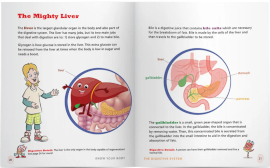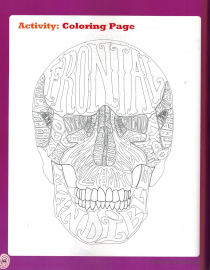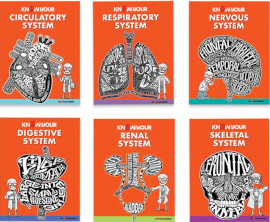I loved the Dr. Bonyfide Presents… series about the skeletal system, which breaks that one body system down into four books with lots of activities and review. The Know Your Body series from the same publisher uses some of the same cartoon characters and the style of presentation, but condenses the skeletal system into a single book, and adds five more books to teach about five other body systems: circulatory, respiratory, nervous, digestive, and renal. Each book is titled Know Your ____ System.
Written for grades three and above, I wouldn’t hesitate to use these with both teens and younger students. Younger students will need more assistance with vocabulary and some activities, while older students might be able to work independently. For students in grades seven and above, these books should make a great supplement for biology courses that often cover human anatomy very briefly.
The content is not dumbed down. Scientific nomenclature is taught along with each body system. For example, page 27 of Know Your Nervous System has an activity where students match 12 specific cranial nerves (e.g., trochlear, olfactory, and vestibulocochlear) with their associated activity, respectively, “Rolling your eyes,” “Taking a sniff of your favorite smell: cinnamon, mint, pine trees,” and “Listening to your favorite song.” Answer keys provided at the end of each book save parents time as well as the embarrassment of admitting they’ve forgotten much of this if they ever learned it.
 These 57-page books are printed in full color and feature Dr. Bonyfide and other cartoon characters. This series presents more straightforward science instruction than the Dr. Bonyfide Presents series since they convey much more information per book. Even so, there are plenty of activities to engage students. Many activity pages have students draw lines to match answers with images, answer multiple-choice questions, fill in blanks with correct answers, and write lengthier answers on one “Think About It” page in each book. Several puzzles—crossword, word search, mazes, and codes—also reinforce learning. In addition, the books each have a few coloring and drawing pages, one or two hands-on activities, and a few recipes (to encourage healthy eating). Corny jokes appear at the bottom of a few pages, such as the one on page 27 of Know Your Skeletal System that asks, “What do you call a skeleton who goes out in the snow?” The answer: “A numb-skull.”
These 57-page books are printed in full color and feature Dr. Bonyfide and other cartoon characters. This series presents more straightforward science instruction than the Dr. Bonyfide Presents series since they convey much more information per book. Even so, there are plenty of activities to engage students. Many activity pages have students draw lines to match answers with images, answer multiple-choice questions, fill in blanks with correct answers, and write lengthier answers on one “Think About It” page in each book. Several puzzles—crossword, word search, mazes, and codes—also reinforce learning. In addition, the books each have a few coloring and drawing pages, one or two hands-on activities, and a few recipes (to encourage healthy eating). Corny jokes appear at the bottom of a few pages, such as the one on page 27 of Know Your Skeletal System that asks, “What do you call a skeleton who goes out in the snow?” The answer: “A numb-skull.”
Some activities are better for younger students, such as lying on the ground and having a friend draw your outline with chalk or making neurons from three colors of playdough (dough recipe included). Just a few activities might more easily be done by older students or demonstrated by parents, such as constructing a model lung (pp. 48-49 of Know Your Respiratory System).
 The drawings of parts of the body in these books are sometimes labeled with artistic lettering as you can see on the coloring page for the skull. This type of lettering is sometimes used on instructional images, but all the coloring pages use it.
The drawings of parts of the body in these books are sometimes labeled with artistic lettering as you can see on the coloring page for the skull. This type of lettering is sometimes used on instructional images, but all the coloring pages use it.
The books continually make real-life connections that help students understand what they are learning. For instance, page 16 in Know Your Digestive System helps students understand the villi and microvilli of the small intestine by looking at fuzzy socks or a sweater. On page 19 of that same book, the lesson about gas as a byproduct of digestion is titled “Gas: A Work O’ Fart.” Kids will probably find this funny, and this slightly crude introduction is used to teach that flatus is the correct word for this smelly gas. It also explains which foods are more likely to produce gas. These are only two examples of how these books connect with kids while teaching serious vocabulary and science content.
Note that the publisher has another series, Systems of the Body: Adventure Series, that covers individual body systems. Some content in that series might be problematic for monotheists, so I don’t recommend them. I didn’t spot any content problems in this new series.
Summary
The Know Your Body series should be great for families with students of varying ages since the content is at a level high enough for older students, yet the drawings and activities make it accessible for younger children.








